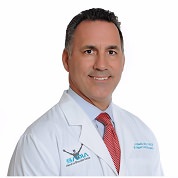Hand and Upper Extremity Orthopedic Surgeon Dr. Alejandro Badia advises early treatment of tennis shoulder; offers tips.
MIAMI (PRWEB) August 23, 2019
As the US Tennis Open nears, both professional and amateur players understand that the game rests squarely on the shoulders, says hand and upper extremity orthopedic surgeon Alejandro Badia MD. “The unnatural mechanism of motion required of the upper limbs for different tennis strokes creates an abnormal amount of stress on joints, especially in the shoulder, no matter whether a player is on the serving or returning side of the ball,” he explains.
“The shoulder is the body’s most mobile structure, able to assume as many as 1,000 different positions,” says Dr. Badia, founder and chief medical officer of the Badia Hand to Shoulder Center andOrthoNOW®. “However, it’s this flexibility that also makes shoulder joints inherently unstable and more prone to problems caused by overuse, injury or aggravation of underlying joint disorders like bursitis and tendonitis.”
Dr. Badia concurs with researchers who say the repetitive, overhead arm movement required in powering a ball during the serve puts a tennis player most at risk for overloading – and destabilizing — the anatomical structures of the shoulder. “This is especially true if the serve is performed with poor technique,” Dr. Badia says.
However, he also points to a relatively recent study in Biomedical Research where scientists report “inadequate preparation” and “too much [racquet] swing force” in a return of service also can cause shoulder injury and damage a tennis player’s rotator cuff. Another common injury is of the labrum, particularly the superior labrum, particularly known to shoulder doctors as the SLAP. The rotator cuff is a group of muscles and tendons supporting the shoulder and providing it with its unusually wide range of motion.
Dr. Badia blames current exercise regimens as much as overuse for development of tennis shoulder pain in younger athletes. “Conditioning programs oftentimes focus on strengthening deltoid muscles – the triangular-shaped muscles on the outer portion of the shoulders – and ignore the rotator cuff,” he says.
In older players, tennis can lead to impingement syndrome, in which the overlying bony arch of the shoulder irritates the rotator cuff tendons and bursa. Presence of age-related bursitis is often a prime culprit for this problem, Dr. Badia says.
“As we age, blood supply to the rotator cuff is diminished, resulting in small, tendon microtears, which can promote tendonitis or even cause larger tears,” he says. Other common causes of “tennis shoulder” are tears in the labrum, the fibrous structure, “akin to a bumper” which leads to the socket being deeper and providing additional stability to the shoulder which is inherently unstable; rotator cuff tears; and shoulder separation, in which the collarbone connects to the acromion which is part of the scapula (shoulder blade). Dr. Badia himself suffered a grade 3 AC joint shoulder dislocation falling when going for a backhand deep in the court.
Shoulder discomfort is extremely common and only behind lumbar back pain and knee pain, affecting as many as 25 percent of adults at any given time. The pain can be deep, persistent and disabling, making it difficult to perform simple daily activities. Depending on type of disorder, symptoms also can include shoulder stiffness, shoulder and arm weakness, limited range of motion, even muscle atrophy.
“It’s the complexity of the shoulder that makes diagnosis and treatment of shoulder disorders a challenge,” Dr. Badia states, adding that patients should seek medical intervention “from a specialist knowledgeable in every aspect of shoulder function” at the earliest stages of a problem to prevent more serious joint complications.
Conservative therapies for relieving mild or moderate tennis-shoulder pain are application of moist heat or ice to affected joints, over-the-counter non-steroidal anti-inflammatory drugs or prescribed medications, rest, physical therapy, corticosteroid injections and injections of appropriate orthobiologic substances (i.e. PRP, protease inhibitors etc). Corticosteroid injections are being used more sparingly by shoulder specialists due the adverse side effects such as creating a tear in poor tissue, or inhibiting the healing response that is so critical.
If these measures fail to resolve the problem, surgery may be necessary, says Dr. Badia, who applies advanced techniques, including arthroscopic surgery and the application of bioinductive implants to augment healing in advancing small, but painful tears. With today’s technologies, open surgery is rare and usually reserved for some type of prosthetic replacement. There are several classes of “arthroplasty” and with the appropriate procedure and dedicated rehab, our more senior players can often also get back on the court.
“Of course, shoulder dysfunction does not have to be the inevitable result of playing tennis or engaging in other sports and activities,” Dr. Badia says. To reduce risks to the shoulder, he offers these tips:
- Talk to an exercise physiologist or orthopedic specialist about stretches – like the sleeper stretch and cross-arm stretch – to strengthen the shoulder’s internal rotation.
- Adequately warm up before a match.
- Engage in rotator cuff strengthening program to help minimize injury including resisted internal and external rotation exercises.
- Pay attention to technique to avoid putting undue stress on joints.
- Use proper equipment. Make sure the tennis racquet, for example, has correct grip size and string tension.
- Take breaks. Particularly it is important to listen to pain. Sometimes rest and strengthening is the best medicine.
Bio: Alejandro Badia, MD, FACS, internationally renowned hand and upper-limb surgeon and founder of Badia Hand to Shoulder Center and OrthoNOW®, a walk-in orthopedic care clinic. He is a member the American Society for Surgery of the Hand, American Association for Hand Surgery and the American Academy of Orthopedic Surgeons. He is a specialist in treating all problems related to the hand and upper extremity including trauma, sports injury, joint reconstruction, nerve injuries and arthroscopic surgeries. OrthoNOWcare.com and drbadia.com

